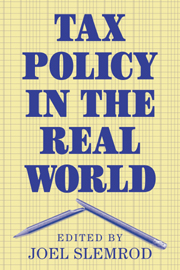Book contents
- Frontmatter
- Contents
- List of contributors
- 1 The real world of tax policy
- 2 Federal tax reform
- 3 Federalism and subfederal taxes
- 4 Principles, politics, and the professors
- Public finance in theory and practice
- On the use of ‘distribution tables’ in the tax policy process
- Taxation and economic growth
- Tax reform of the century – the Swedish experiment
- Measuring the impact of tax reform
- What is an ‘optimal’ tax system?
- How tax complexity and enforcement affect the equity and efficiency of the income tax
- Tax policy from a public choice perspective
- What is missed if we leave out collective choice in the analysis of taxation
- Public finance and public choice
- Professional opinions about tax policy: 1994 and 1934
- What can America learn from the British tax system?
- Peculiar institutions: a British perspective on tax policy in the United States
- Index
Tax policy from a public choice perspective
Published online by Cambridge University Press: 01 June 2010
- Frontmatter
- Contents
- List of contributors
- 1 The real world of tax policy
- 2 Federal tax reform
- 3 Federalism and subfederal taxes
- 4 Principles, politics, and the professors
- Public finance in theory and practice
- On the use of ‘distribution tables’ in the tax policy process
- Taxation and economic growth
- Tax reform of the century – the Swedish experiment
- Measuring the impact of tax reform
- What is an ‘optimal’ tax system?
- How tax complexity and enforcement affect the equity and efficiency of the income tax
- Tax policy from a public choice perspective
- What is missed if we leave out collective choice in the analysis of taxation
- Public finance and public choice
- Professional opinions about tax policy: 1994 and 1934
- What can America learn from the British tax system?
- Peculiar institutions: a British perspective on tax policy in the United States
- Index
Summary
Abstract - Tax policy is a product of politics, so a complete understanding of tax policy requires an explicit recognition of the political environment within which tax policy is made. The paper emphasizes the concept of political costs associated with the tax system and discusses several aspects of tax policy using a public choice approach. The paper argues that the political costs associated with taxation can be minimized by embedding the tax system within a relatively inflexible fiscal constitution. Despite the insights the public choice perspective offers, most analysis of tax policy does not take public choice considerations into account.
Despite the fact that the tax structure is a product of the political process, rarely does an economic analysis of tax policy take account of the political environment within which the tax structure is designed. The political environment is important for several reasons. Most obviously, because the tax structure is a product of politics, one must understand the political process to completely understand the tax system. Furthermore, if the tax structure is designed appropriately, the collective choice process can provide a revealed preference mechanism that can help enhance the efficiency of government both on the tax side and the expenditure side of the ledger. Also, public choice analysis might lend some insight into what constitutes an equitable tax structure.
- Type
- Chapter
- Information
- Tax Policy in the Real World , pp. 397 - 410Publisher: Cambridge University PressPrint publication year: 1999
- 2
- Cited by



